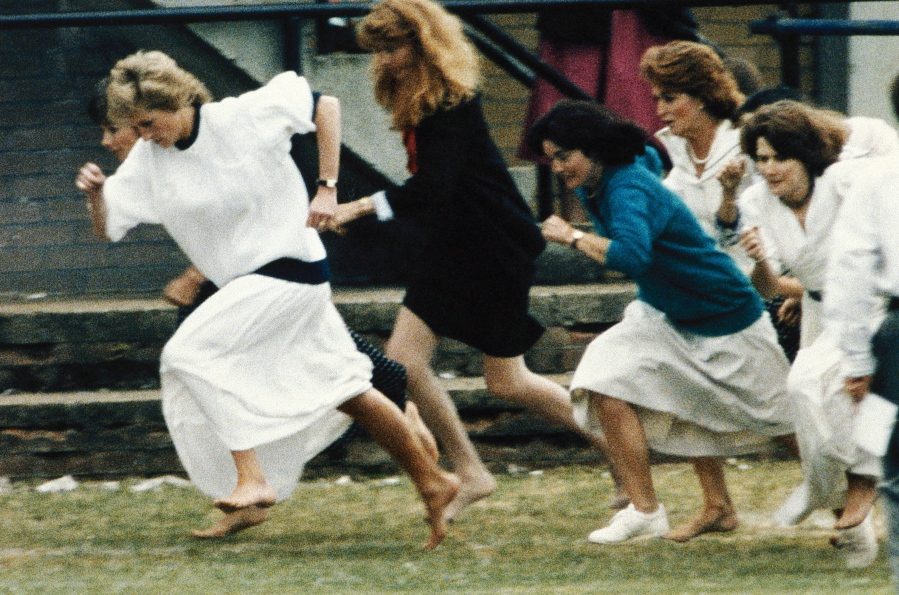LONDON — Most people wouldn’t volunteer to walk through a minefield. Princess Diana did it twice.
On Jan. 15, 1997, Diana walked gingerly down a narrow path cleared through an Angolan minefield, wearing a protective visor and flak jacket emblazoned with the name of The HALO Trust, a group devoted to removing mines from former war zones. When she realized some of the photographers accompanying her didn’t get the shot, she turned around and did it again.
Later, she met with a group of landmine victims. A young girl who had lost her left leg perched on the princess’s lap.
The images of that day appeared in newspapers and on TV sets around the globe, focusing international attention on the then-languishing campaign to rid the world of devices that lurk underground for decades after conflicts end. Today, a treaty banning landmines has 164 signatories.
Those touched by the life of the preschool teacher turned princess remembered her ahead of what would have been her 60th birthday on Thursday, recalling the complicated royal rebel who left an enduring imprint on the House of Windsor.
Diana had the “emotional intelligence that allowed her to see that bigger picture … but also to bring it right down to individual human beings,” said James Cowan, a retired major general who is now CEO of The HALO Trust. “She knew that she could reach their hearts in a way that would outmaneuver those who would only be an influence through the head.”
Diana’s walk among the landmines seven months before she died in a Paris car crash is just one example of how she helped make the monarchy more accessible, changing the way the royal family related to people. By interacting more intimately with the public — kneeling to the level of a child, sitting on the edge of a patient’s hospital bed, writing personal notes to her fans — she connected with people in a way that inspired other royals, including her sons, Princes William and Harry, as the monarchy worked to become more human and remain relevant in the 21st century.
Diana didn’t invent the idea of royals visiting the poor, destitute or downtrodden. Queen Elizabeth II herself visited a Nigerian leper colony in 1956. But Diana touched them — literally.
“Diana was a real hugger in the royal family,’’ said Sally Bedell Smith, author of “Diana in Search of Herself.’’ “She was much more visibly tactile in the way she interacted with people. It was not something the queen was comfortable with and still is not.’’
Ten years before she embraced landmine victims in Angola, she shook hands with a young AIDS patient in London during the early days of the epidemic, showing people that the disease couldn’t be transmitted through touch.
As her marriage to Prince Charles deteriorated, Diana used the same techniques to tell her side of the story. Embracing her children with open arms to show her love for her sons. Sitting alone in front of the Taj Mahal on a royal trip to India. Walking through that minefield as she was starting a new life after her divorce.
“Diana understood the power of imagery — and she knew that a photograph was worth a hundred words,’’ said Ingrid Seward, editor-in-chief of Majesty magazine and author of “Diana: An Intimate Portrait.’’ “She wasn’t an intellectual. She wasn’t ever going to be the one to give the right words. But she gave the right image.”
And that began on the day the 20-year-old Lady Diana Spencer married Prince Charles, the heir to throne, on July 29, 1981, at St. Paul’s Cathedral.
Elizabeth Emanuel, who co-designed her wedding dress, describes an event comparable to the transformation of a chrysalis into a butterfly, or in this case a nursery school teacher in cardigans and sensible skirts into a fairytale princess.
“We thought, right, let’s do the biggest, most dramatic dress possible, the ultimate fairytale dress. Let’s make it big. Let’s have big sleeves. Let’s have ruffles,’’ Emanuel said. “And St. Paul’s was so huge. We knew that we needed to do something that was a statement. And Diana was completely up for that. She loved that idea.’’
But Emanuel said Diana also had a simplicity that made her more accessible to people.
“She had this vulnerability about her, I think, so that ordinary people could relate to her. She wasn’t perfect. And none of us are perfect, and I think that’s why there is this thing, you know, people think of her almost like family. They felt they knew her.”



